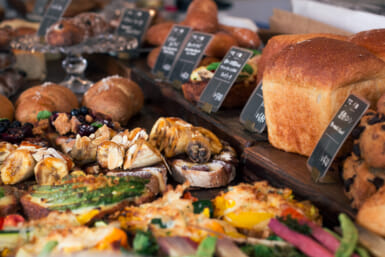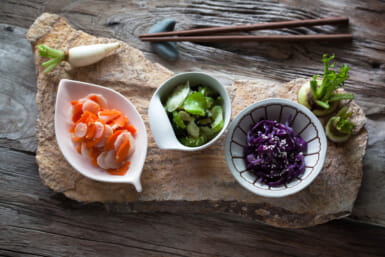To dine at La Tour d’Argent in Tokyo is to experience the unique, something no other restaurant I know can offer, not even its parent, the world-famous La Tour d’Argent in Paris.
When you enter its doors off the lobby of the Hotel New Otani, you suddenly cut yourself off from the hustle and bustle of the real world and end the cares of the day. Just a few steps, and you’re away from the madding crowd, in sublime surroundings where all is soft, soundless and elegant; where you are treated like a king—or queen, if the other sex, the lesser man, as Tennyson put it—and everything seems aimed at your comfort and pleasure.
I write in an excess of epicurean happiness, as I have just experienced the pleasures which La Tour d’Argent has to offer. Perhaps it is the the contrast with what I had recently gone through that causes me to react with such enthusiasm, for I have traveled a lot lately and undergone a lot of gastronomic hardships.
I had also dragged my poor wife along, forcing her to suffer them also. So, returning to this reconstruction of voluptuous Sybaris, I decided to take her out to dine royally and gave her the choice of restaurants. She picked La Tour d’Argent.
Of course, I was happy with the choice, as I knew that dining there would wipe out the memory of the ghastly flavors my palate had experienced.
We walked into this repository of elegant bliss, identified ourselves for reservation purposes and were led to the lounge to sink into the deep softness of a well-stuffed chair. Outside was a view of the hotel’s marvelous garden; inside, luxury at its best, with walls filled with portraits of 16th and 17th century patrons of the restaurant which, according to gastronome Christian Millau, is the oldest in the world, having got its start in 1582.
The paintings gave me a feeling of being in a world of the past, a reaction further stimulated by the courteous staff under Michel de Lepine, the efficient and ubiquitous maitre d’.
Christian Bollard, representative director of the restaurant, under whose careful hand the Tokyo branch operates, appeared with Claude Terrail, the owner. Terrail was here to make a personal check of the operation. I am sure he was pleased with what he saw.
He joined us and regaled us with stories of interest and humor, such as the introduction of the fork to France. It was in Henry III’s reign (1575-1589) when the French first saw that implement used by Italians to their astonishment at La Tour d’Argent. The Italians would spear a piece of meat with the two-pronged utensil, bring it up over their ruffs— de rigueur in those days—take the food off with their hands and put it in their mouths.
Then there was the time that Pierpoint Morgan of the Morgan billions visited the restaurant cellars, spotted two Napoleon (REAL Napoleon, vintage 1811) cognacs and offered a fortune for them. The offer was declined. But Morgan was not to be denied. By some sleight-of-hand (some say he hired a James Bond-type to do the job), the bottles disappeared. In their place was a letter of apology and a blank check. The check was sent back, but not the bottles. Typical of filthy-rich men, I thought. Never let anything go, no matter how they got it.
About that time de Lepine appeared and signaled that our table was ready. We followed him through the softly-lit passage, past the glassed-in settings for the three emperors and a 1788 cognac in the wall, to the dining area. On the way, de Lepine told us there was a new chef, Jean-Pierre LeManissier.
“I think you will like his menu,” he said. It turned out to be a great understatement. For what he produced for us was fit for the table of the Olympian gods, although I don’t really believe the Olympians dined so well, confining their diet mainly to nectar and honey.
But I must rush on, as I am running out of space and I can see Corky with an evil grin and blue pencil poised. So I shall have to hurry through our dinner, a crime if I had done so at the restaurant.
We both had Cassoulet d’Escargot or snails in a burgundy sauce. With it we ordered a Champagne La Tour d’Argent. The snails were excellent, the wine of the sauce coming through loud and clear. As for the champagne, it was full-bodied and obviously contained a good percentage of Pinot Noir grapes. It also went very well with my Feuillete de St. Jacques and my wife’s Ecrivisses de Chantilly, which followed.
My scallops were placed on a thin crust and surrounded by a white sauce made with white wine and cream. Her crayfish lay on a bed of thin slices of avocado and served with a sauce made of whipped cream, spinach and a sort of mayonnaise, giving it a green color. She was ecstatic over them. As for my scallops, I cannot remember having had better.
For a main course she selected a Chartreuse de Canard, slices of duck with a sauce of truffles, cabbage (marvelous, she said), and I had a magnificent Filet de Boeuf d’Orsay, a very tender steak served with a light sauce containing white wine and asparagus. It received an A with several plusses from me. With those dishes, I ordered a Beaune Clos du Roy, 1983 which, though a bit young, flowered forth with full bouquet and excellent body and flavor.
A Brie in fine condition ended this grand feast and helped us finish the wine.
Monsieurs Bollard, de Lepine and LeManassier, stand up and take your bows.








